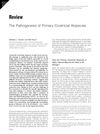signaling protein that, when suppressed, may grow hair by reducing inflammation and stem cell loss
autoimmune disorder causing patchy hair loss
natural substance from Neem tree with medicinal and pesticidal properties
Microscopic delivery system that sends growth-promoting signals to hair follicles



